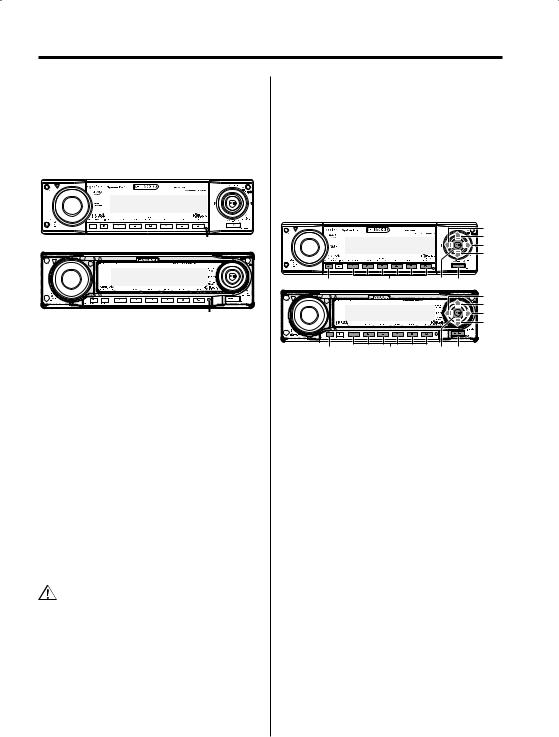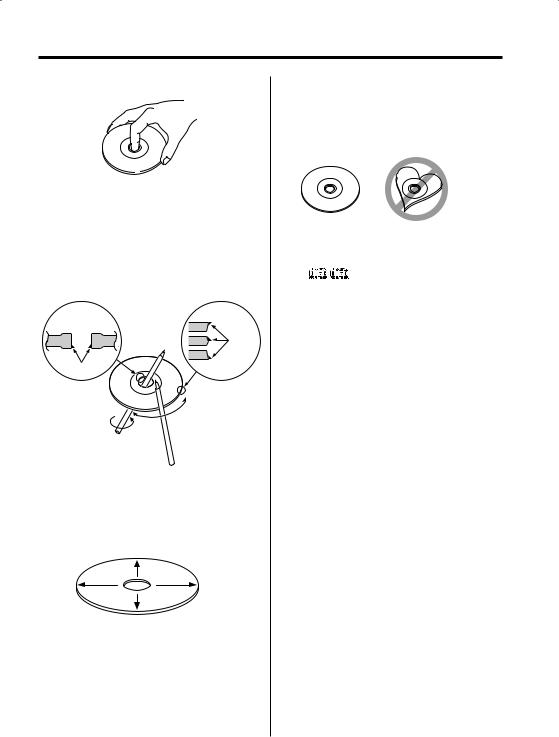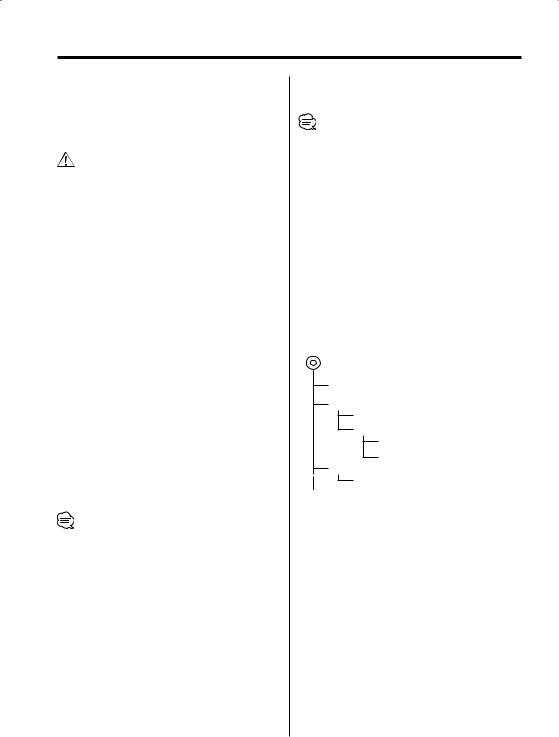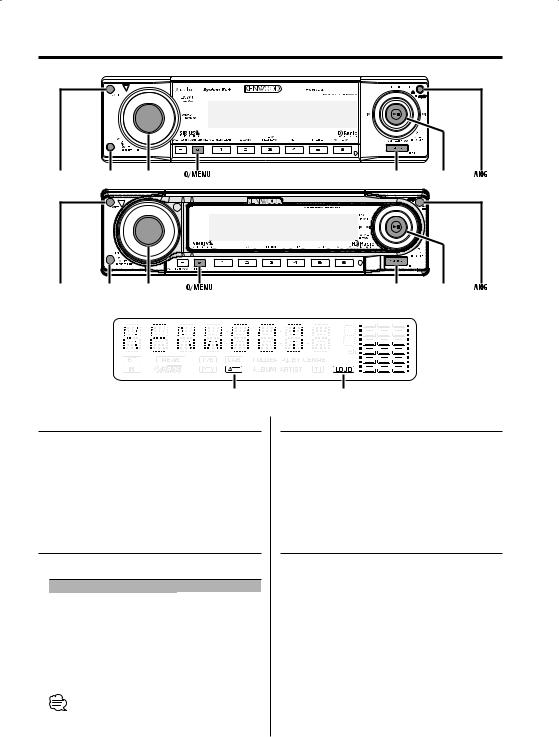Kenwood KDC-X589, KDC-MP5028, KDC-MP528 User Manual

CD-RECEIVER
KDC-X589 KDC-MP5028 KDC-MP528
INSTRUCTION MANUAL
Take the time to read through this instruction manual. Familiarity with installation and operation procedures will help you obtain the best performance from your new CD-receiver.
For your records
Record the serial number, found on the back of the unit, in the spaces designated on the warranty card, and in the space provided below. Refer to the model and serial numbers whenever you call upon your KENWOOD dealer for information or service on the product.
Model KDC-X589, KDC-MP5028, KDC-MP528 Serial number
© B64-2975-00/00 (KW)

Contents
Safety precautions |
4 |
Notes |
5 |
Warning |
6 |
About CDs |
7 |
About AAC, MP3 and WMA |
8 |
General features |
9 |
Power
Selecting the Source
Volume
Attenuator
System Q
Audio Control
Audio Setup
Subwoofer Output
Speaker Setting
Switching Display
Station/Disc Naming (SNPS/DNPS)
Faceplate Angle Adjustment
Theft Deterrent Faceplate
TEL Mute
Tuner features |
15 |
Tuning
Tuning Mode
Direct Access Tuning
Station Preset Memory
Auto Memory Entry
Preset Tuning
CD/Audio file/External disc control
features |
17 |
Playing CD & Audio file
Playing External Disc
Fast Forwarding and Reversing
Track/File Search
Disc Search/Folder Search
Direct Track/File Search
Direct Disc Search
Track/File/Disc/Folder Repeat
Scan Play
Random Play
Magazine Random Play
Disc Random Play
Folder Select
Switching the Play mode
Letter Seek
Text/Title Scroll
2 | English
HD Radio control features |
22 |
Tuning |
|
Menu system |
23 |
Menu System
Security Code Touch Sensor Tone
Manual Clock Adjustment
DSI (Disabled System Indicator) Selectable Illumination Dimmer
Switching preout Built-in Amp Setting
Dual Zone System Setting
B.M.S. (Bass Management System) B.M.S. Frequency Offset
AMP Control
CRSC (Clean Reception System Circuit) Receive mode Setting
SIRIUS ID (ESN) display
Auxiliary Input Display Setting & Station/Disc Naming
Text Scroll
Built-in Auxiliary input Setting CD Read Setting
Voice Index
ACDrive firmware version display Unique ID display
Audio Preset Memory Audio Preset Call
Demonstration mode Setting
Basic Operations of remote |
30 |
Accessories/ Installation Procedure |
32 |
Connecting Wires to Terminals |
33 |
Installation |
34 |
Removing the Unit |
36 |
Troubleshooting Guide |
37 |
Specifications |
40 |

The "AAC" logo is trademark of Dolby Laboratories.
English | 3

Safety precautions
2WARNING
To prevent injury or fire, take the following precautions:
•To prevent a short circuit, never put or leave any metallic objects (such as coins or metal tools) inside the unit.
Attach the panel while you are on the vehicle
The panel lock arm will be appeared when the panel is removed. Therefore, the panel must be attached during the driving.
2CAUTION
To prevent damage to the machine, take the following precautions:
•Make sure to ground the unit to a negative 12V DC power supply.
•Do not install the unit in a spot exposed to direct sunlight or excessive heat or humidity. Also avoid places with too much dust or the possibility of water splashing.
•Do not set the removed faceplate or the faceplate case in areas exposed to direct sunlight, excessive heat or humidity. Also avoid places with too much dust or the possibility of water splashing.
•To prevent deterioration, do not touch the terminals of the unit or faceplate with your fingers.
•Do not subject the faceplate to excessive shock, as it is a piece of precision equipment.
•When replacing a fuse, only use a new one with the prescribed rating. Using a fuse with the wrong rating may cause your unit to malfunction.
•Do not apply excessive force to the open faceplate or place objects on it. Doing so will cause damage or breakdown.
•Do not use your own screws. Use only the screws provided. If you use the wrong screws, you could damage the unit.
Do Not Load 3-in. CDs in the CD slot
If you try to load a 3 in. CD with its adapter into the unit, the adapter might separate from the CD and damage the unit.
4 | English
About CD players/disc changers connected to this unit
KENWOOD disc changers/ CD players released in 1998 or later can be connected to this unit. Refer to the catalog or consult your Kenwood dealer for connectable models of disc changers/ CD players.
Note that any KENWOOD disc changers/ CD players released in 1997 or earlier and disc changers made by other makers cannot be connected to this unit.
Unsupported connection may result in damage. Setting the "O-N" Switch to the "N" position for the applicable KENWOOD disc changers/ CD players. The functions that can be used and the information that can be displayed will differ depending on the models being connected.
•You can damage both your unit and the CD changer if you connect them incorrectly.
LX-bus connection
The LX AMP and the sensor unit cannot be connected simultaneously.
You must connect any of them at a time.
Lens Fogging
Right after you turn on the car heater in cold weather, dew or condensation may form on the lens in the CD player of the unit. Called lens fogging, CDs may be impossible to play. In such a situation, remove the disc and wait for the condensation to evaporate. If the unit still does not operate normally after a while, consult your Kenwood dealer.
NOTE
This Class B digital apparatus complies with Canadian ICES-003.

Notes
•If you experience problems during installation, consult your Kenwood dealer.
•If the unit fails to operate properly, press the Reset button. The unit returns to factory settings when the Reset button is pressed.
•Press the reset button if the disc auto changer fails to operate correctly. Normal operation should be restored.
Reset button
Reset button
•We recommend the use of <Security Code> (page 24) to prevent theft.
•The characters which can be displayed by this unit are A-Z 0-9 @ " ‘ ` % & * + – = , . / \ < > [ ] ( ) : ; ^ - { } | ~ .
•The illustrations of the display and the panel appearing in this manual are examples used to explain more clearly how the controls are used. Therefore, what appears on the display in the illustrations may differ from what appears on the display on the actual equipment, and some of the illustrations on the display may represent something impossible in actual operation.
Cleaning the Unit
If the faceplate of this unit is stained, wipe it with a dry soft cloth such as a silicon cloth.
If the faceplate is stained badly, wipe the stain off with a cloth moistened with neutral cleaner, then wipe neutral detergent off.
•Applying spray cleaner directly to the unit may affect its mechanical parts. Wiping the faceplate with a hard cloth or using a volatile liquid such as thinner or alcohol may scratch the surface or erases characters.
Cleaning the Faceplate Terminals
If the terminals on the unit or faceplate get dirty, wipe them with a dry, soft cloth.
Before using this unit for the first time
This unit is initially set on the Demonstration mode. When using this unit for the first time, cancel the <Demonstration mode Setting> (page 29).
About SIRIUS Satellite radio tuner
Refer to the instruction manual of SIRIUS Satellite radio tuner KTC-SR901/SR902/SR903 (optional accessory), when connected, for the operation method.
• Refer to the sections of A models for operations.
|
'. 4$3- |
D |
". |
"650 |
o |
43$ |
|
'. 4$3- |
D |
". |
"650 |
o |
43$ |
English | 5

Notes |
|
2Warning |
About DAB Tuner control
Refer to A group on the Instruction manual of DAB Tuner KTC-9090DAB (optional accessory) for the control method of DAB Tuner function.
However, the following control methods of the function for this unit may be differed from the Instruction manual; therefore, refer to the following supplemental instruction.
<Auto Ensemble Memory Entry>
1.Select the preset band for Auto Ensemble Memory Entry.
2.Press the [AME] button for at least 2 seconds. Open Auto Ensemble Memory Entry.
After storing in the memory finishes, the number of the pre-set buttons and the ensemble label are displayed.
<Searching by programme type and language> and <Languages to be displayed> in <Programme Type (PTY) Function>
At the operation to press [DISP] button, press [AUTO] button.
About "Media Manager" of PC application attached to KDC-X589
•"Media Manager" is recorded in the CD-ROM attached to this unit.
•Refer to the attached installation manual for the installation method of "Media Manager".
•Refer to the user’s manual recorded in the installation CD-ROM and Help of "Media Manager" for the operation method of "Media Manager".
•The unit can play CD (hereafter called "ACDrive disc") created by "Media Manager".
•Refer to the following site for the updated information of "Media Manager". http://www.kenwood.mediamanager.jp/
•Contact Kenwood for the function and operation of the "Media Manager".
•"Media Manager" is a product of PhatNoise.
6 | English
2CAUTION
Use of controls or adjustments or performance of procedures other than those specified herein may result in hazardous radiation exposure.
In compliance with Federal Regulations, following are reproductions of labels on, or inside the product relating to laser product safety.
KENWOOD CORPORATION 2967-3, ISHIKAWA-MACHI, HACHIOJI-SHI
TOKYO, JAPAN
KENWOOD CORP. CERTIFIES THIS EQUIPMENT CONFORMS TO DHHS REGULATIONS N0.21 CFR 1040. 10, CHAPTER 1, SUBCHAPTER J.
Location : Bottom Panel
FCC WARNING
This equipment may generate or use radio frequency energy. Changes or modifications to this equipment may cause harmful interference unless the modifications are expressly approved in the instruction manual. The user could lose the authority to operate this equipment if an unauthorized change or modification is made.
NOTE
This equipment has been tested and found to comply with the limits for a Class B digital device, pursuant to Part 15 of the FCC Rules. These limits are designed to provide reasonable protection against harmful interference in a residential installation. This equipment may cause harmful interference to radio communications, if it is
not installed and used in accordance with the instructions. However, there is no guarantee that interference will not occur in a particular
installation. If this equipment does cause harmful interference to radio or television reception, which can be determined by turning the equipment off and on, the user is encouraged to try to correct the interference by one or more of the following measures:
•Reorient or relocate the receiving antenna.
•Increase the separation between the equipment and receiver.
•Connect the equipment into an outlet on a circuit different from that to which the receiver is connected.
•Consult the dealer or an experienced radio/TV technician for help.

About CDs
Handling CDs
• Don’t touch the recording surface of the CD.
•CD-R and CD-RW are easier to damage than a normal music CD. Use a CD-R or a CD-RW after reading the caution items on the package etc.
•Don’t stick tape etc. on the CD.
Also, don’t use a CD with tape stuck on it.
When using a new CD
If the CD center hole or outside rim has burrs, use it after removing them with a ball pen etc.
Burrs
Burrs
CD accessories
Don’t use disc type accessories.
CD cleaning
Clean from the center of the disc and move outward.
Removing CDs
When removing CDs from this unit pull them out horizontally.
CDs that can’t be used
• CDs that aren’t round can’t be used.
•CDs with coloring on the recording surface or that are dirty can’t be used.
•This unit can only play the CDs with


 .
.
It may not correctly play discs which do not have the mark.
•A CD-R or CD-RW that hasn’t been finalized can’t be played. (For the finalization process refer to your CD-R/CD-RW writing software, and your CD- R/CD-RW recorder instruction manual.)
CD storage
•Don’t place them in direct sunlight (On the seat or dashboard etc.) and where the temperature is high.
•Store CDs in their cases.
English | 7

About AAC, MP3 and WMA
The playable AAC/MP3/WMA file (hereafter called Audio file) and the media format has the following limitation. The Audio file, which is out of the specification, may not able to be played normally, or the file and folder names may not be displayed correctly.
•Attach the correct extension for the Audio file (AAC: ".M4A", MP3: ".MP3", WMA: ".WMA")
•Do not attach the extensions to the other files besides the Audio file. If it is attached, the file, which is not the Audio file, will be played and outputs the loud noise, and then the speaker will be damaged.
•The files with copy protection cannot be played.
Playable AAC file
•".m4a" file encoded by AAC-LC format.
Refer to http://www.kenwood.mediamanager.jp/ for the details.
Playable MP3 file
•MPEG 1/2 Audio Layer 3 file
•Transfer bit rate: 8-320 kbps
•Sampling frequency
KDC-X589: 16, 22.05, 24, 32, 44.1, 48 kHz KDC-MP5028/MP528: 8, 11.025, 12, 16, 22.05, 24,
32, 44.1, 48 kHz
Playable WMA file
•The file in accordance with Windows Media Audio (Except for the file for Windows Media Player 9 or after which applies the new functions)
•Transfer bit rate: 48-192 kbps
•Sampling frequency: 32, 44.1, 48 kHz
Playable media
•CD-ROM, CD-R, CD-RW
•Depending on the writing software, it may not be possible to use quick formatted CD-RW discs.
•When recording to the media up to the maximum capacity at once, the writing soft is set to "Disc at once".
Playable disc format
•ISO 9660 Level 1/2
•Joliet
•Romeo
•Long file name.
The maximum number of characters for display
File/Folder name: KDC-X589: 128 characters
KDC-MP5028/MP528: 64 characters
MP3 ID3 Tag/ WMA Contents property/ AAC song information (KDC-X589 only): 30 characters
•File/Folder name is the number of the characters including the extensions.
•MP3 ID3 Tag can only display the tag of Ver1.X. (KDCMP5028/MP528 only)
•AAC ID3 Tag cannot be displayed.
Limitation of structure for the file and the folder
•Maximum number of directory levels: 8
•Maximum number of folders: 100
•Maximum number of files per folder: KDC-X589: 4096, KDC-MP5028/MP528: 255
Playing order of the Audio file
The Audio file is played in the order which is written by writing soft. You may be able to set the playing order by writing the play sequence numbers such as "01" to "99" at the beginning of the file name.
Example
CD (1) 0: Folder
¡: Audio file
¡!
2¡" 3 ¡#
¡$
4¡%
•Playing order
Playing order after ¡! play.
¡", ¡#, ¡$, ¡%...
•File search
Forward file search during ¡# play.
Push the Control knob to [¢] ¡$
•Folder search
Forward folder search during ¡" play.
Push the Control knob to [FM] 3, 4...
•Folder select
When it is set to directory 4, skip to the folder before the same level by folder select.
Push the Control knob to [4] 2
When it is set to directory 3, makes the level up by folder select.
Push the Control knob to [AM] 2
8 | English

General features
"55 |
Release button |
70- |
43$ |
Control knob |
"55 |
Release button |
70- |
43$ |
Control knob |
ATT indicator |
LOUD indicator |
Power
Turning ON the Power
Press the [SRC] button.
Turning OFF the Power
Press the [SRC] button for at least 1 second.
Selecting the Source
Press the [SRC] button.
Source required |
Display |
SIRIUS tuner (Optional accessory) |
"SIRIUS" |
Tuner or HD Radio (Optional accessory) |
"TUNER" or "HD RADIO" |
CD |
"CD" |
External disc (Optional accessory) |
"CD CH" |
Auxiliary input* |
"AUX" |
Auxiliary input (Optional accessory) |
"AUX EXT" |
Standby (Illumination only mode) |
"STANDBY" |
Volume
Increasing Volume
Turn the [VOL] knob clockwise.
Decreasing Volume
Turn the [VOL] knob counterclockwise.
Attenuator
Turning the volume down quickly.
Press the [ATT] button.
Each time the button is pressed, the Attenuator turns ON and OFF.
When it’s ON, the "ATT" indicator blinks.
• Function of the KDC-MP5028/MP528.
English | 9

General features
System Q
You can recall the best sound setting preset for different types of music.
1Select the source to set
Press the [SRC] button.
2Select the Sound type
Press the [Q] button.
Each time the button is pressed, the sound setting switches.
Sound setting |
Display |
User memory |
"USER" |
Rock |
"ROCK" |
Pops |
"POPS" |
Easy |
"EASY" |
Top 40 |
"TOP40" |
Jazz |
"JAZZ" |
Natural |
"NATURAL" |
•User memory: The values set on the <Audio Control> (page 10).
•Each setting value is changed with the <Speaker Setting> (page 12).
First, select the speaker type with the Speaker setting.
Audio Control
1Select the source for adjustment
Press the [SRC] button.
2Enter Audio Control mode
Press the [VOL] knob.
3Select the Basic Audio item for adjustment
Press the [VOL] knob.
Each time the knob is pressed, the items that can be adjusted switch as shown below.
4Adjust the Basic Audio item
Turn the [VOL] knob.
Adjustment Item |
Display |
Range |
Rear Volume *1 |
"R-VOL" |
0 — 35 |
Subwoofer level*2,3,4 |
"SW L" |
–15 — +15 |
Bass level*5,6 |
"BAS L" |
–8 — +8 |
Middle level*5,6 |
"MID L" |
–8 — +8 |
Treble level*5,6 |
"TRE L" |
–8 — +8 |
Balance |
"BAL" |
Left 15 — Right 15 |
10 | English
Fader*4 |
"FAD" |
Rear 15 — Front 15 |
Exit Audio Control mode
•*1 You can control this item when "2ZON" of <Audio Setup> (page 11) is set to "ON".
•*2 You can control this item when <Switching preout> (page 25) is set to "SWPRE SW". (KDC-MP5028/ MP528 only)
•*3 You can control this item when <Subwoofer Output> (page 11) is set to "SW ON".
•*4 You can control this item when "2ZON" of <Audio Setup> (page 11) is set to "OFF".
•*5 These items can be adjusted in detail by the following methods. (Function of the KDC-X589)
•*6 Source tone memory: The set up value is put in the memory per source. (Detail Audio item is included)
5Exit Audio Control mode
Press any button.
Press the button which is not [VOL] knob and [ATT]/ [ANG] button.
Adjust the detail of Audio Control
1Select the Audio item for adjustment
By referring to the step 1 — 3 above, select the desired item to be set in detail from the items marked with *5.
2Enter Detail adjustment mode of Audio Control
Press the [VOL] knob for at least 1 second.
3Select the Detail Audio item for adjustment
Press the [VOL] knob.
Each time the knob is pressed, the items that can be adjusted switch as shown below.
4Adjust the Detail Audio item
Turn the [VOL] knob.
Bass level
Adjustment Item |
Display |
Range |
Bass Center Frequency |
"BAS F" |
40/50/60/70/80/100/ |
|
|
120/150 Hz |
Bass Q Factor |
"BAS Q" |
1.00/1.25/1.50/2.00 |
Bass Extend |
"B EX" |
OFF/ON |
Middle level |
|
|
Adjustment Item |
Display |
Range |
Middle Center Frequency |
"MID F" |
0.5/1.0/1.5/2.0 kHz |
Middle Q Factor |
"MID Q" |
1.0/2.0 |
Treble level |
|
|
Adjustment Item |
Display |
Range |
Treble Center Frequency |
"TRE" |
10.0/12.5/15.0/17.5 kHz |

5 Exit the Detail Audio Control mode
Press the [VOL] knob for at least 1 second.
•When the Bass Extend is set to ON, low frequency response is extended by 20%.
•You can exit the Audio Control mode at anytime by pressing any button except for [VOL], [ATT] and [ANG] buttons.
Audio Setup
Setting the Sound system, such as Cross over Network.
1Select the source for adjustment
Press the [SRC] button.
2Enter Audio Setup mode
Press the [VOL] knob for at least 1 second.
3Select the Audio Setup item for adjustment
Press the [VOL] knob.
Each time the knob is pressed, the items that can be adjusted switch as shown below.
4Setup the Audio item
Turn the [VOL] knob.
Adjustment Item |
Display |
Range |
Front High Pass Filter*2 |
"HPF" |
Through/40*³/60*³/80/100/ |
|
|
120/ 150/180/220*³ Hz |
Rear High Pass Filter*2 |
"HPR" |
Through/40*³/60*³/80/100/ |
|
|
120/ 150/180/220*³ Hz |
Low Pass Filter*1,2 |
"LPF" |
50*³/60/80/100*³/120/ |
|
|
Through Hz |
Subwoofer Phase*1,2 |
"PHAS" |
Normal (0°)/ Reverse (180°) |
Volume offset |
"V-OFF" |
–8 — ±0 |
Loudness |
"LOUD" |
OFF/ON |
Dual Zone System*4 |
"2ZON" |
OFF/ON |
• Volume offset: Each source’s volume can be set as a difference from the basic volume.
• Loudness: Compensating for low and high tones during low volume.
When it's ON, "LOUD" indicator is ON.
•*1You can control this item when <Switching preout> (page 25) is set to "SWPRE SW". (Function of the KDCMP5028/MP528)
•*1 You can control this item when <Subwoofer Output> (page 11) is set to "SW ON".
•*2 You can control this item when "2ZON" of <Audio Setup> (page 11) is set to "OFF".
•*³ KDC-X589/MP5028 only.
•* The Dual Zone System can be used with the Auxiliary input sources shown below.
-Internal auxiliary input (KDC-MP5028/MP528 only)
-Option CA-C1AX (KDC-X589 only)
•Dual Zone System
Main source and sub source (Auxiliary input) output Front channel and Rear channel separately.
-The channel of sub source is set up by <Dual Zone System Setting> (page 25).
-Main source is selected by [SRC] button.
-The volume of Front channel is adjusted by [VOL] knob.
-The volume of Rear channel is adjusted by <Audio Control> (page 10).
-The Audio Control has no effect on sub source.
5Exit Audio Setup mode
Press [VOL] knob for at least 1 second.
Subwoofer Output
Turning the Subwoofer output ON or OFF.
Hold down on [AM] of the Control knob for at least 1 second.
Each time the button is pressed, Subwoofer output switches ON and OFF.
When it’s ON, "SW ON" is displayed.
•You can control this item when <Switching preout> (page 25) is set to "SWPRE SW". (KDC-MP5028/MP528 only)
•You can control this item when "2ZON" of <Audio Setup> (page 11) is set to "OFF".
English | 11

General features
Speaker Setting
Fine-tuning so that the System Q value is optimal when setting the speaker type.
1Enter Standby
Press the [SRC] button.
Select the "STANDBY" display.
2Enter Speaker Setting mode
Press the [VOL] knob.
3Select the Speaker type
Turn the [VOL] knob.
Each time the knob is turned, the setting switches as shown below.
Speaker type |
Display |
|
OFF |
|
"SP OFF" |
For 5 |
& 4 in. speaker |
"SP 5/4" |
For 6 |
& 6x9 in. speaker |
"SP 6x9/6" |
For the OEM speaker |
"SP OEM" |
|
4Exit Speaker Setting mode
Press the [VOL] knob.
Switching Display
Switching the information displayed.
1Enter Switching Display mode
Press the Control knob for at least 1 second.
"DISP SEL" is displayed.
2Select the Display item
Push the Control knob to [4] or [¢].
In Tuner source
|
Information |
Display |
|
Station name or Frequency |
"SNPS" |
|
Frequency |
"FREQ" |
|
Clock |
"CLOCK" |
In CD & External disc source |
||
|
|
|
|
Information |
Display |
|
Disc title |
"D-TITLE"* |
|
Track title |
"T-TITLE"* |
|
Track number & Play time |
"P-TIME" |
|
Disc name |
"DNPS" |
|
Clock |
"CLOCK" |
In Audio file source
|
|
Information |
Display |
|
|
Song title & Artist name |
"TITLE"* |
|
|
Album name & Artist name |
"ALBUM"* |
|
|
Folder name |
"FOLDER" |
|
|
File name |
"FILE" |
|
|
Track number & Play time |
"P-TIME" |
|
|
Clock |
"CLOCK" |
In HD Radio source |
|
||
|
|
|
|
|
|
Information |
Display |
|
|
Station name |
"ST NAME"* |
|
|
Song title/ Artist name/ |
"TITLE"* |
|
|
Album name/ Genre |
|
|
|
Frequency |
"FREQ" |
|
|
Clock |
"CLOCK" |
In SIRIUS tuner source |
|
||
|
|
|
|
|
|
Information |
Display |
|
|
Channel name |
"CH NAME" |
|
|
Song title |
"SONG" |
|
|
Artist name |
"ARTIST" |
|
|
Composer name |
"COMPOSER" |
|
|
Category name |
"CATEGORY" |
|
|
Label name |
"LABEL" |
|
|
Comment |
"COMMENT" |
|
|
Band & Channel number |
"CH NUM" |
|
|
Clock |
"CLOCK" |
In Auxiliary input source/ Standby source
Information |
Display |
Source name |
"SRC NAME" |
Clock |
"CLOCK" |
3Exit Switching Display mode
Press the Control knob.
•When LX-AMP is connected, the item setup by the Display mode of LX-AMP is displayed. (KDC-X589 only)
•* If the contents of the information cannot be displayed, Play time or Frequency is displayed.
•Track number at Audio file displays the last 3 digits when it exceeds 1000 songs (KDC-X589 only).
•Album name cannot be displayed in WMA file. (KDCMP5028/MP528 only)
•Song title, Artist name, and Album name cannot be displayed in AAC file. (KDC-MP5028/MP528 only)
12 | English
